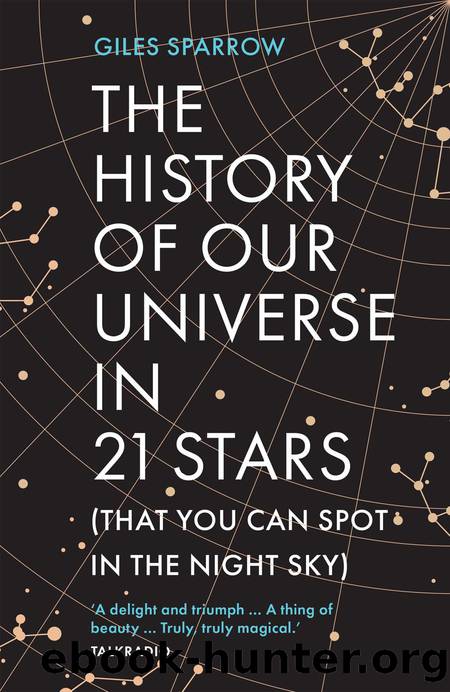The History of Our Universe in 21 Stars: (That you can Spot in the Night Sky) by Giles Sparrow

Author:Giles Sparrow
Language: eng
Format: epub
ISBN: 9781802797589
Publisher: Welbeck
Siriusâs name derives from the ancient Greek for âthe scorching oneâ. For obvious reasons, plenty of cultures around the world have linked it to particularly powerful deities, but itâs more puzzling just how many have linked it to a dog of some sort. Far beyond European influence, Chinese stargazers saw it as the star of the celestial wolf, and the Native American Blackfoot people referred to it as âDogfaceâ. One possible explanation is that the Dog Star got its association because people imagined it following its master â the fairly obvious humanoid figure of Orion.
Another widespread association for Sirius â across the northern hemisphere at least â was as the herald of summer. This might seem odd today, when weâre used to greeting its arrival in evening skies from November, but our ancestors, living without artificial lighting, were evidently of the âearly to bed, early to riseâ school. They welcomed Sirius at its first appearance in the pre-dawn sky an hour or so before sunrise. For most of the Mediterranean and Near East, this so-called âhelical risingâ acted as a mark of the peak of summer heat â an effect sometimes attributed to the heat of Sirius and the Sun combined93. In ancient Egypt some 5,000 years ago, however, it was rather more important. The Dog Starâs reappearance in early July was a reliable indicator for the onset of the Nileâs flood season â a torrent of muddy waters from the African interior that the Kingdom of the Pharaohs relied upon to sustain its agriculture and prosperity94.
While Siriusâs brightness made it a focus for astrologers throughout late classical and medieval times, once the Enlightenment came along it took on a new importance as a potential target for distance-revealing parallax measurements (see Chapter 2). In 1717, when the famous Edmond Halley rooted through Ptolemyâs second-century star catalogue the Almagest, he found that the recorded position for Sirius had drifted by 30 minutes of arc, the width of a Full Moon. Because this large âproper motionâ, along with its prominence in the sky, suggested Sirius was probably a nearby star (and thus likely to show a tell-tale shift in direction as Earth orbited the Sun) several failed attempts to measure its position were made over the next century.
Sirius remained high on the list of potential nearby stars through to the 1830s, when technology finally caught up with ambition and Bessel and Struve raced to make the first successful parallax measurement (as recounted in Chapter 2). However, both ultimately fixed their attentions elsewhere, and so it was left to Scottish astronomer Thomas Henderson to calculate the distance to the Dog Star in 18391. With a distance of 8.6 light years by modern measures, it remained the second-closest known star system (after Alpha Centauri) until the discovery of the first faint red dwarf stars in the early 1900s.
The Dog Starâs brightness and distance together imply an overall energy output about 25 times greater than the Sun, while its mass is only about twice as much.
Download
This site does not store any files on its server. We only index and link to content provided by other sites. Please contact the content providers to delete copyright contents if any and email us, we'll remove relevant links or contents immediately.
Tools of Titans by Timothy Ferriss(8308)
Turbulence by E. J. Noyes(7983)
Secrets of Antigravity Propulsion: Tesla, UFOs, and Classified Aerospace Technology by Ph.D. Paul A. Laviolette(5336)
Astrophysics for People in a Hurry by Neil DeGrasse Tyson(5152)
Room 212 by Kate Stewart(5073)
Design of Trajectory Optimization Approach for Space Maneuver Vehicle Skip Entry Problems by Runqi Chai & Al Savvaris & Antonios Tsourdos & Senchun Chai(5040)
Pale Blue Dot by Carl Sagan(4960)
The David Icke Guide to the Global Conspiracy (and how to end it) by David Icke(4658)
A Journey Through Divination and Astronomy by Publishing Pottermore(4364)
Goodbye Paradise(3766)
Apollo 8 by Jeffrey Kluger(3672)
COSMOS by Carl Sagan(3592)
The Five People You Meet in Heaven by Mitch Albom(3522)
Losing the Nobel Prize by Brian Keating(3521)
How to Read Water: Clues and Patterns from Puddles to the Sea (Natural Navigation) by Tristan Gooley(3434)
Brief Answers to the Big Questions by Stephen Hawking(3394)
How to Read Nature by Tristan Gooley(3294)
The Order of Time by Carlo Rovelli(3164)
A Brief History of Time by Stephen Hawking(2994)
